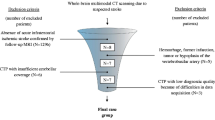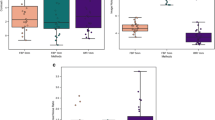Abstract
Objectives
In this study, we aimed to determine whether iterative model reconstruction designed for brain CT (IMR-neuro) would improve the accuracy of posterior fossa stroke diagnosis on brain CT.
Methods
We enrolled 37 patients with ischaemic stroke in the posterior fossa and 37 patients without stroke (controls). Using axial images reconstructed using filtered back-projection (FBP) and IMR-neuro, we compared the CT numbers in infarcted areas, image noise in the pons, and contrast-to-noise ratios (CNRs) of infarcted and non-infarcted areas on scans subjected to IMR-neuro and FBP. To analyse the performance of hypo-attenuation detection, we used receiver-operating characteristic (ROC) curve techniques.
Results
The image noise was significantly lower (2.2 ± 0.5 vs. 5.1 ± 0.9 Hounsfield units, p < 0.01) and the difference in CNR between the infarcted and non-infarcted areas was significantly higher with IMR-neuro than with FBP (2.2 ± 1.7 vs. 4.0 ± 3.6, p < 0.01). Furthermore, the average area under the ROC curve was significantly higher with IMR-neuro (0.90 vs. 0.86 for FBP, p = 0.04).
Conclusion
IMR-neuro yielded better image quality and improved hypo-attenuation detection in patients with ischaemic stroke.
Key points
• Iterative model reconstruction of brain CT data can facilitate the diagnosis of ischaemic stroke.
• IMR improved the detectability of low-contrast lesions in the posterior fossa.
• IMR-neuro yielded better image quality and improved observer performance.





Similar content being viewed by others

References
Bernick C, Kuller L, Dulberg C et al (2001) Silent MRI infarcts and the risk of future stroke: the cardiovascular health study. Neurology 57:1222–1229
Joseph PM, Ruth C (1997) A method for simultaneous correction of spectrum hardening artifacts in CT images containing both bone and iodine. Med Phys 24:1629–1634
Rozeik C, Kotterer O, Preiss J, Schutz M, Dingler W, Deininger HK (1991) Cranial CT artifacts and gantry angulation. J Comput Assist Tomogr 15:381–386
Ogawa A, Mori E, Minematsu K et al (2007) Randomized trial of intraarterial infusion of urokinase within 6 hours of middle cerebral artery stroke: the middle cerebral artery embolism local fibrinolytic intervention trial (MELT) Japan. Stroke 38:2633–2639
Block KT, Uecker M, Frahm J (2009) Model-based iterative reconstruction for radial fast spin-echo MRI. IEEE Trans Med Imaging 28:1759–1769
Deak Z, Grimm JM, Treitl M et al (2013) Filtered back projection, adaptive statistical iterative reconstruction, and a model-based iterative reconstruction in abdominal CT: an experimental clinical study. Radiology 266:197–206
Pickhardt PJ, Lubner MG, Kim DH et al (2012) Abdominal CT with model-based iterative reconstruction (MBIR): initial results of a prospective trial comparing ultralow-dose with standard-dose imaging. AJR Am J Roentgenol 199:1266–1274
Katsura M, Matsuda I, Akahane M et al (2012) Model-based iterative reconstruction technique for radiation dose reduction in chest CT: comparison with the adaptive statistical iterative reconstruction technique. Eur Radiol 22:1613–1623
Chang W, Lee JM, Lee K et al (2013) Assessment of a model-based, iterative reconstruction algorithm (MBIR) regarding image quality and dose reduction in liver computed tomography. Invest Radiol 48:598–606
Nakaura T, Iyama Y, Kidoh M et al (2016) Comparison of iterative model, hybrid iterative, and filtered back projection reconstruction techniques in low-dose brain CT: impact of thin-slice imaging. Neuroradiology 58:245–251
Puetz V, Sylaja PN, Coutts SB et al (2008) Extent of hypoattenuation on CT angiography source images predicts functional outcome in patients with basilar artery occlusion. Stroke 39:2485–2490
Koc G, Courtier JL, Phelps A, Marcovici PA, MacKenzie JD (2014) Computed tomography depiction of small pediatric vessels with model-based iterative reconstruction. Pediatr Radiol 44:787–794
Dzialowski I, Weber J, Doerfler A, Forsting M, von Kummer R (2004) Brain tissue water uptake after middle cerebral artery occlusion assessed with CT. J Neuroimaging 14:42–48
Brooks RA, Di Chiro G (1976) Statistical limitations in x-ray reconstructive tomography. Med Phys 3:237–240
Barber PA, Demchuk AM, Zhang J, Buchan AM (2000) Validity and reliability of a quantitative computed tomography score in predicting outcome of hyperacute stroke before thrombolytic therapy. ASPECTS Study Group. Alberta Stroke Programme Early CT Score Lancet 355:1670–1674
Haubenreisser H, Fink C, Nance JW Jr et al (2014) Feasibility of slice width reduction for spiral cranial computed tomography using iterative image reconstruction. Eur J Radiol 83:964–969
Kijewski PK, Bjarngard BE (1978) Correction for beam hardening in computed tomography. Med Phys 5:209–214
Kidoh M, Nakaura T, Awai K et al (2013) Novel connecting tube for saline chaser in contrast-enhanced CT: the effect of spiral flow of saline on contrast enhancement. Eur Radiol 23:3213–3218
Nakaura T, Kidoh M, Sakaino N et al (2013) Low radiation dose protocol in cardiac CT with 100 kVp: usefulness of display preset optimization. Int J Cardiovasc Imaging 29:1381–1389
Kidoh M, Nakaura T, Nakamura S et al (2014) Reduction of dental metallic artifacts in CT: value of a newly developed algorithm for metal artifact reduction (O-MAR). Clin Radiol 69:e11–e16
Kidoh M, Nakaura T, Nakamura S et al (2014) Low-contrast-dose protocol in cardiac CT: 20% contrast dose reduction using 100 kVp and high-tube-current-time setting in 256-slice CT. Acta Radiol 55:545–553
Nakaura T, Nagayoshi Y, Awai K et al (2014) Myocardial bridging is associated with coronary atherosclerosis in the segment proximal to the site of bridging. J Cardiol 63:134–139
Acknowledgements
The scientific guarantor of this publication is Yasuyuki Yamashita. The authors of this manuscript declare no relationships with any companies whose products or services may be related to the subject matter of the article. The authors state that this work has not received any funding. No complex statistical methods were necessary for this paper. Written informed consent was waived by the Institutional Review Board. Institutional Review Board approval was obtained. Methodology: retrospective, diagnostic or prognostic study, performed at one institution.
Author information
Authors and Affiliations
Corresponding author
Rights and permissions
About this article
Cite this article
Inoue, T., Nakaura, T., Yoshida, M. et al. Diagnosis of small posterior fossa stroke on brain CT: effect of iterative reconstruction designed for brain CT on detection performance. Eur Radiol 27, 3710–3715 (2017). https://doi.org/10.1007/s00330-017-4773-4
Received:
Revised:
Accepted:
Published:
Issue Date:
DOI: https://doi.org/10.1007/s00330-017-4773-4



